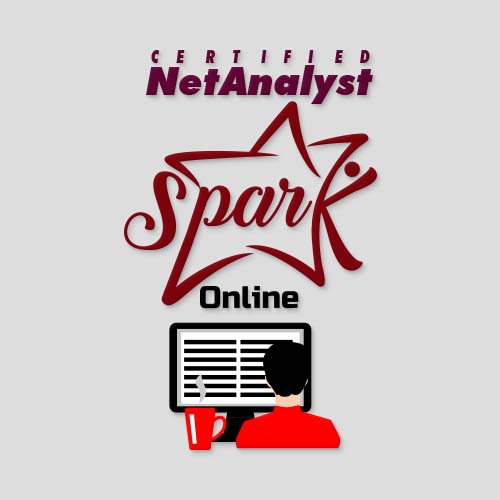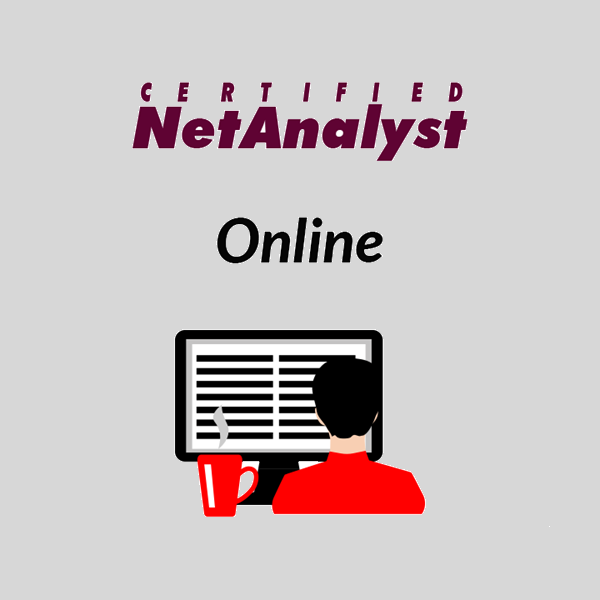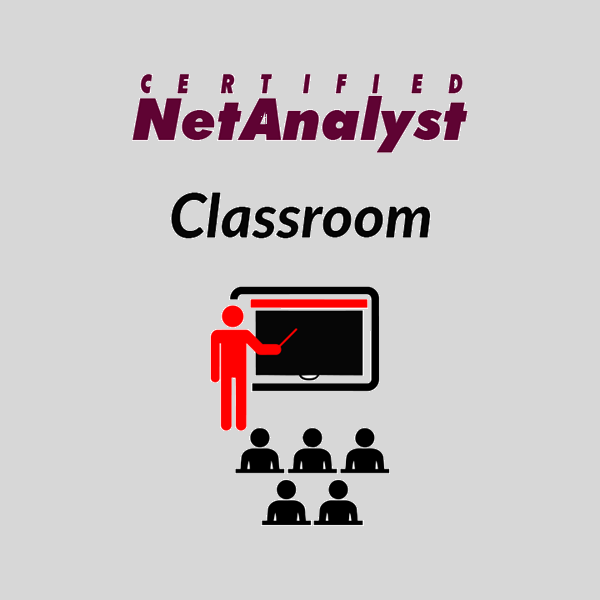NetAnalyst Certification
ROOT CAUSE ANALYSIS TRAINING

NetAnalyst Spark
Intimidated by network packets? Do packets remind you of unrecognizable “goulash” from leftovers? Or maybe you’ve not yet seen a packet. Packet Sniffing Skills gets you up to speed and comfortable getting results from using an analyzer to go deeper to diagnose slowness and problems from client to server, application and all points between. Packet sniffing uncovers problems impossible to diagnose through typical methods – often in minutes.
Choose NetAnalyst Level I Training to learn network theory and initial network analyzer operation.
NetAnalyst Spark Online
Starting Skills- ONLINE COURSE TEXT Capture a packet trace during your problem noting the time of the issue and the symptom. For added diagnostic value, screenshot your screen or record a video of your user activity while the trace is captured and the problem occurs.
Network Troubleshooting at its Best – Invest an hour a week.
12 Week Online Course Description
Learn the essential fundamental concepts required to maintain a network at peak performance. The information is presented thoroughly with plenty of hands-on training. For the best experience, we suggest you follow along with your own analyzer.
Who Should Attend
Technologists responsible for maintaining networks including communication and technical managers, system engineers, WAN/LAN administrators and all network support personnel.
Course Outline
Network Analysis Essentials
- OSI model comes alive!
- Packet capture basics
- IEEE Addressing
- Overview of protocol stacks
- LAN encapsulation – Etype, SAP, SNAP, RAW
- Building packets layer by layer
- Problems described by OSI layer
Switched Network Analysis & VLANs
- Learn, Flood, Forward and Filtering
- Bridge/Switch Concept Test
- Special Protocol Concerns IP, IPX local routing
- MAC Address anatomy
- Spanning Tree Loop Detection & Blocking
- Root selection, Designated Bridge selection
- Priority and Path Cost block scenarios
- Switch Applications – how to avoid problems
- Full Duplex Issues and Auto-negotiation problems
- Measuring Latency and Throughput Testing
- Port Span and Mirror Issues and other methods
- VLAN Theory and Operation
Ethernet Operation & Analysis
- Manchester, NRZI, MLT-3 & 4b/5b encoding
- Overhead beyond the packet headers
- Media access timing and back-off algorithms
- The truth about auto-negotiation
- Packet transmit time and collision examples
Throughput & Latency Analysis
- Sources of latency
- How some protocols overcome latency and some don’t?
- Pinpointing theoretical latency
- Reliable transport layers TCP, NSP, SPX, LLC2, SPP
- Reliable application layers over IP: Sun NFS, NCP burst
- Measuring latency — multiple methods
- Burst vs, request reply protocols
IP Operation & Analysis
- IP technical design history
- Configuration essentials, ARP, Proxy ARP, RARP
- Addressing made simple using Tool Kit and Tables!
- Broadcasts, subnet masks and pop quiz
- A story for every field in the header — examples!
- Fragmentation illustrated
- IP routing algorithm — how it all works
- Router operation and design history
- ICMP explained by example
- Tracing IP packet flow exercise
- Packet transmit time and router port buffer queue size

NetAnalyst I PACKET SNIFFING SKILLS
Intimidated by network packets? Do packets remind you of unrecognizable “goulash” from leftovers? Or maybe you’ve not yet seen a packet. Packet Sniffing Skills gets you up to speed and comfortable getting results from using an analyzer to go deeper to diagnose slowness and problems from client to server, application and all points between. Packet sniffing uncovers problems impossible to diagnose through typical methods – often in minutes.
Choose NetAnalyst Level I Training to learn network theory and initial network analyzer operation.
NetAnalyst Packet Sniffing Online
ESSENTIAL SKILLS- ONLINE COURSE TEXT Capture a packet trace during your problem noting the time of the issue and the symptom. For added diagnostic value, screenshot your screen or record a video of your user activity while the trace is captured and the problem occurs.
Network Troubleshooting at its Best – Invest an hour a week.
26 Week Online Course Description
Learn the essential fundamental concepts required to maintain a network at peak performance. The information is presented thoroughly with plenty of hands-on training. For the best experience, we suggest you follow along with your own analyzer.
Who Should Attend
Technologists responsible for maintaining networks including communication and technical managers, system engineers, WAN/LAN administrators and all network support personnel.
Course Outline
Network Analysis Essentials
- OSI model comes alive!
- Packet capture basics
- IEEE Addressing
- Overview of protocol stacks
- LAN encapsulation – Etype, SAP, SNAP, RAW
- Building packets layer by layer
- Problems described by OSI layer
Switched Network Analysis & VLANs
- Learn, Flood, Forward and Filtering
- Bridge/Switch Concept Test
- Special Protocol Concerns IP, IPX local routing
- MAC Address anatomy
- Spanning Tree Loop Detection & Blocking
- Root selection, Designated Bridge selection
- Priority and Path Cost block scenarios
- Switch Applications – how to avoid problems
- Full Duplex Issues and Auto-negotiation problems
- Measuring Latency and Throughput Testing
- Port Span and Mirror Issues and other methods
- VLAN Theory and Operation
Ethernet Operation & Analysis
- Manchester, NRZI, MLT-3 & 4b/5b encoding
- Overhead beyond the packet headers
- Media access timing and back-off algorithms
- The truth about auto-negotiation
- Packet transmit time and collision examples
Throughput & Latency Analysis
- Sources of latency
- How some protocols overcome latency and some don’t?
- Pinpointing theoretical latency
- Reliable transport layers TCP, NSP, SPX, LLC2, SPP
- Reliable application layers over IP: Sun NFS, NCP burst
- Measuring latency — multiple methods
- Burst vs, request reply protocols
IP Operation & Analysis
- IP technical design history
- Configuration essentials, ARP, Proxy ARP, RARP
- Addressing made simple using Tool Kit and Tables!
- Broadcasts, subnet masks and pop quiz
- A story for every field in the header — examples!
- Fragmentation illustrated
- IP routing algorithm — how it all works
- Router operation and design history
- ICMP explained by example
- Tracing IP packet flow exercise
- Packet transmit time and router port buffer queue size

NetAnalyst II PACKET ROOT CAUSE ANALYSIS
NetAnalyst Level II Training to learn deeper theory and troubleshooting methods to solve more complex problems. A healthy mix of
to learn network theory and initial network analyzer operation. This course plus significant on the job training and other vendor training and certifications prepares the student to take the Certified NetAnalyst Level I Test. Unlike other training and certification programs there is no guarantee that one will pass the test. Passing the test requires immersion in the subject matter, with personal and professional diligence to troubleshoot real problems opposed to passing a test. The test requires study, work experience and applying one self to diagnose network problems.
NetAnalyst Root Cause Analysis
DEEP PACKET ANALYSIS- Root Cause Deep Packet Classroom Training A Certified NetAnalyst Level II or above will guide you through to diagnosis. Problem analysis strategy, the tools, setup, the test, monitoring, validation and a one page report per day will be written providing annotated and narrative findings.
Network Troubleshooting at its Best – Invest an hour a week.
26 Week Online Course Description
Learn the essential fundamental concepts required to maintain a network at peak performance. The information is presented thoroughly with plenty of hands-on training. For the best experience, we suggest you follow along with your own analyzer.
Who Should Attend
Technologists responsible for maintaining networks including communication and technical managers, system engineers, WAN/LAN administrators and all network support personnel.
Course Outline
Network Analysis Essentials
- OSI model comes alive!
- Packet capture basics
- IEEE Addressing
- Overview of protocol stacks
- LAN encapsulation – Etype, SAP, SNAP, RAW
- Building packets layer by layer
- Problems described by OSI layer
Switched Network Analysis & VLANs
- Learn, Flood, Forward and Filtering
- Bridge/Switch Concept Test
- Special Protocol Concerns IP, IPX local routing
- MAC Address anatomy
- Spanning Tree Loop Detection & Blocking
- Root selection, Designated Bridge selection
- Priority and Path Cost block scenarios
- Switch Applications – how to avoid problems
- Full Duplex Issues and Auto-negotiation problems
- Measuring Latency and Throughput Testing
- Port Span and Mirror Issues and other methods
- VLAN Theory and Operation
Ethernet Operation & Analysis
- Manchester, NRZI, MLT-3 & 4b/5b encoding
- Overhead beyond the packet headers
- Media access timing and back-off algorithms
- The truth about auto-negotiation
- Packet transmit time and collision examples
Throughput & Latency Analysis
- Sources of latency
- How some protocols overcome latency and some don’t?
- Pinpointing theoretical latency
- Reliable transport layers TCP, NSP, SPX, LLC2, SPP
- Reliable application layers over IP: Sun NFS, NCP burst
- Measuring latency — multiple methods
- Burst vs, request reply protocols
IP Operation & Analysis
- IP technical design history
- Configuration essentials, ARP, Proxy ARP, RARP
- Addressing made simple using Tool Kit and Tables!
- Broadcasts, subnet masks and pop quiz
- A story for every field in the header — examples!
- Fragmentation illustrated
- IP routing algorithm — how it all works
- Router operation and design history
- ICMP explained by example
- Tracing IP packet flow exercise
- Packet transmit time and router port buffer queue size

NetAnalyst III DEEP PACKET SECURITY FORENSICS
Security Deep Packet Analysis
NetAnalyst Level I Training to learn network theory and initial network analyzer operation. This course plus significant on the job training and other vendor training and certifications prepares the student to take the Certified NetAnalyst Level I Test. Unlike other training and certification programs there is no guarantee that one will pass the test. Passing the test requires immersion in the subject matter, with personal and professional diligence to troubleshoot real problems opposed to passing a test. The test requires study, work experience and applying one self to diagnose network problems.
Security Deep Packet Analysis
Security Analysis- SECURITY DEEP PACKET ANALYSIS Sometimes physical security dictates you need a NetAnalyst Onsite to collaborate with a large team or several teams. A NetAnalyst Level III or above travels to your site expediently and starts to diagnose your issue.
Network Troubleshooting at its Best – Invest an hour a week.
26 Week Online Course Description
Learn the essential fundamental concepts required to maintain a network at peak performance. The information is presented thoroughly with plenty of hands-on training. For the best experience, we suggest you follow along with your own analyzer.
Who Should Attend
Technologists responsible for maintaining networks including communication and technical managers, system engineers, WAN/LAN administrators and all network support personnel.
Course Outline
Network Analysis Essentials
- OSI model comes alive!
- Packet capture basics
- IEEE Addressing
- Overview of protocol stacks
- LAN encapsulation – Etype, SAP, SNAP, RAW
- Building packets layer by layer
- Problems described by OSI layer
Switched Network Analysis & VLANs
- Learn, Flood, Forward and Filtering
- Bridge/Switch Concept Test
- Special Protocol Concerns IP, IPX local routing
- MAC Address anatomy
- Spanning Tree Loop Detection & Blocking
- Root selection, Designated Bridge selection
- Priority and Path Cost block scenarios
- Switch Applications – how to avoid problems
- Full Duplex Issues and Auto-negotiation problems
- Measuring Latency and Throughput Testing
- Port Span and Mirror Issues and other methods
- VLAN Theory and Operation
Ethernet Operation & Analysis
- Manchester, NRZI, MLT-3 & 4b/5b encoding
- Overhead beyond the packet headers
- Media access timing and back-off algorithms
- The truth about auto-negotiation
- Packet transmit time and collision examples
Throughput & Latency Analysis
- Sources of latency
- How some protocols overcome latency and some don’t?
- Pinpointing theoretical latency
- Reliable transport layers TCP, NSP, SPX, LLC2, SPP
- Reliable application layers over IP: Sun NFS, NCP burst
- Measuring latency — multiple methods
- Burst vs, request reply protocols
IP Operation & Analysis
- IP technical design history
- Configuration essentials, ARP, Proxy ARP, RARP
- Addressing made simple using Tool Kit and Tables!
- Broadcasts, subnet masks and pop quiz
- A story for every field in the header — examples!
- Fragmentation illustrated
- IP routing algorithm — how it all works
- Router operation and design history
- ICMP explained by example
- Tracing IP packet flow exercise
- Packet transmit time and router port buffer queue size
NetAnalyst Certification
ROOT CAUSE ANALYSIS TRAINING

NetAnalyst Spark
Intimidated by network packets? Do packets remind you of unrecognizable “goulash” from leftovers? Or maybe you’ve not yet seen a packet. Packet Sniffing Skills gets you up to speed and comfortable getting results from using an analyzer to go deeper to diagnose slowness and problems from client to server, application and all points between. Packet sniffing uncovers problems impossible to diagnose through typical methods – often in minutes.
Choose NetAnalyst Level I Training to learn network theory and initial network analyzer operation.
NetAnalyst Spark Online
Starting Skills- ONLINE COURSE TEXT Capture a packet trace during your problem noting the time of the issue and the symptom. For added diagnostic value, screenshot your screen or record a video of your user activity while the trace is captured and the problem occurs.
Network Troubleshooting at its Best – Invest an hour a week.
12 Week Online Course Description
Learn the essential fundamental concepts required to maintain a network at peak performance. The information is presented thoroughly with plenty of hands-on training. For the best experience, we suggest you follow along with your own analyzer.
Who Should Attend
Technologists responsible for maintaining networks including communication and technical managers, system engineers, WAN/LAN administrators and all network support personnel.
Course Outline
Network Analysis Essentials
- OSI model comes alive!
- Packet capture basics
- IEEE Addressing
- Overview of protocol stacks
- LAN encapsulation – Etype, SAP, SNAP, RAW
- Building packets layer by layer
- Problems described by OSI layer
Switched Network Analysis & VLANs
- Learn, Flood, Forward and Filtering
- Bridge/Switch Concept Test
- Special Protocol Concerns IP, IPX local routing
- MAC Address anatomy
- Spanning Tree Loop Detection & Blocking
- Root selection, Designated Bridge selection
- Priority and Path Cost block scenarios
- Switch Applications – how to avoid problems
- Full Duplex Issues and Auto-negotiation problems
- Measuring Latency and Throughput Testing
- Port Span and Mirror Issues and other methods
- VLAN Theory and Operation
Ethernet Operation & Analysis
- Manchester, NRZI, MLT-3 & 4b/5b encoding
- Overhead beyond the packet headers
- Media access timing and back-off algorithms
- The truth about auto-negotiation
- Packet transmit time and collision examples
Throughput & Latency Analysis
- Sources of latency
- How some protocols overcome latency and some don’t?
- Pinpointing theoretical latency
- Reliable transport layers TCP, NSP, SPX, LLC2, SPP
- Reliable application layers over IP: Sun NFS, NCP burst
- Measuring latency — multiple methods
- Burst vs, request reply protocols
IP Operation & Analysis
- IP technical design history
- Configuration essentials, ARP, Proxy ARP, RARP
- Addressing made simple using Tool Kit and Tables!
- Broadcasts, subnet masks and pop quiz
- A story for every field in the header — examples!
- Fragmentation illustrated
- IP routing algorithm — how it all works
- Router operation and design history
- ICMP explained by example
- Tracing IP packet flow exercise
- Packet transmit time and router port buffer queue size
